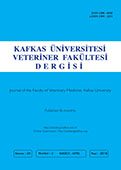
This journal is licensed under a Creative Commons Attribution-NonCommercial 4.0 International License
Kafkas Üniversitesi Veteriner Fakültesi Dergisi
2018 , Vol 24 , Issue 2
Pathomorphological and Immunohistochemical Findings of Subacute Lobullary Calcifying Panniculitis in Two Cats
1Ankara University, Faculty of Veterinary Medicine, Department of Pathology, TR-06110 Diskapi, Ankara - TURKEY2Mustafa Kemal Univ., Faculty of Veterinary Medicine, Department of Pathology, TR-31060 Alahan, Antakya/Hatay - TURKEY DOI : 10.9775/kvfd.2017.18745 This report aimed to reveal the characteristics of calcifying panniculitis in two cats. Two biopsies taken from the lumbosacral region of an 8-month old and a 1-year old, male, mixed breed cats were evaluated. Macroscopically, there were masses of different sizes varying from 1.5 to 2.5 cm in diameter. The masses had a generally firmness and were grayish-white in colour. Histopathology revealed necrotic and degenerative lipocytes in lobules of subcutaenous fat tissue. In some areas, there were lymphocyte, macrophage and neutrophil leukocytes infiltrations and connective tissue proliferation. There were also large calcifying areas at the centre of degenerated-necrotic fat lobules. Alizarin Red S detected the calcifying areas and Masson"s trichrome differentiated connective tissue proliferation. In ABC-P, CD3 slightly reacted with lymphocytes and lymphoblasts. Vimentin moderately reacted with connective tissue proliferation at the periphery of the necrotic areas and the septum. A1AC reacted in the cytoplasm of macrophages and peripheral necrotic areas. No reaction was determined with A1AT. In conclusion, such cases have not been documented in veterinary pathology. It is believed that the two cats possibly had a renal deficiency problem or nephrotic syndrome in the pathogenetic mechanism. It was also considered that A1AC (serine proteinase inhibitor) expressions could have a role in such cases despite there being no A1AT (another serine proteinase inhibitor) expression. Keywords : Calcifying panniculitis, Cat, Immunohistochemistry, Pathomorphology










